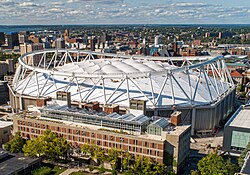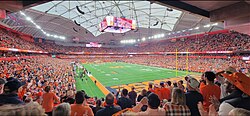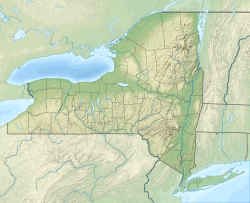JMA Wireless Dome
"The Loud House" | |
JMA Wireless Dome in 2021 | |
Location in the United States Location in New York | |
| Former names | Carrier Dome (1980–2022) |
|---|---|
| Address | 900 Irving Avenue |
| Location | Syracuse, New York, United States |
| Coordinates | 43°2′10″N 76°8′11″W / 43.03611°N 76.13639°W |
| Owner | Syracuse University |
| Capacity | Football: 42,784[1] (2024–present) Former capacity List
Ice Hockey: 39,925 Concerts: 56,250 |
| Record attendance | (Football), 50,564 (September 20, 1980) (Basketball), 35,642 (February 23, 2019) |
| Surface | FieldTurf (2015–present) AstroTurf (1980–2004) |
| Construction | |
| Broke ground | November 11, 1978[3] |
| Opened | September 20, 1980 |
| Construction cost | $25.63 million $118 million (renovations in 2021) $45 million (renovations in 2022) |
| Architect | Finch-Heery Hueber Hares Glavin[4] |
| Structural engineer | Geiger Associates[5] (original structure and 2021–22 renovations) |
| General contractor | Huber, Hunt & Nichols[4] |
| Tenants | |
Syracuse Orange (NCAA)
| |
| Website | |
| cuse.com/carrier-dome | |
The JMA Wireless Dome, originally the Carrier Dome (1980–2022) and colloquially called "The Dome," or more recently "The JMA Dome," is a domed stadium in Syracuse, New York, United States. Located on the campus of Syracuse University in the University Hill neighborhood,[6] it is home to the Syracuse Orange football, basketball, and lacrosse teams. In 2006–07, the women's basketball team began playing home games in the Carrier Dome. In May 2022, Syracuse University announced in April 2022 that Carrier Global Corp. would no longer hold naming rights to the venue. When Syracuse University and JMA Wireless announced the new naming rights in May 2022, it marked the first time the venue's name would change since the opening in 1980.[7]
Since its opening 44 years ago in September 1980, the Syracuse men's basketball team has led the NCAA in average attendance 16 times and holds the NCAA records for highest total home court attendance in a season (537,949, 1990), highest average home court attendance in a season (29,918, 1989), and the largest home court single game attendance (35,642, vs. Duke, 2019).[8]
The JMA Wireless Dome is the largest domed stadium of any college campus, and the largest domed stadium in the northeastern United States. It is also the largest on-campus basketball arena in the nation, with a listed capacity of 35,642.[9][10] In addition, the venue hosts high school football state championships, the annual New York State Field Band Conference championships, and occasional concerts.
History
[edit]Toward the end of the 1970s, Syracuse University was under pressure to improve its football facilities in order to remain a Division I-A football school. Its on-campus stadium, Archbold Stadium, opened in 1907 and had not aged well. The stadium could not be expanded; earlier in the decade it had been reduced from 40,000 seats to 26,000 due to stricter enforcement of fire codes. Therefore, the university decided to build a new stadium on the site of Archbold, which, appropriately for the region's often cold weather, was to have a domed Teflon-coated, fiberglass inflatable roof.[11][12]
Because it was built in-season in 1979 on the previous stadium's site, Syracuse played "home" games at three different locations—New Jersey's Giants Stadium, home of the National Football League's New York Giants; Rich Stadium, home of the Buffalo Bills; and Schoellkopf Field, home of the Cornell Big Red.[13] When it opened in September 1980, it was made clear just how loud it was inside; that night the new stadium's nickname, "the Loud House", was coined.[14] The original inflatable roof, since replaced by a fixed roof, caused the sound produced to echo many times, multiplying the loudness produced inside.
The stadium also became the home of the men's basketball team, as a replacement for Manley Field House.[15]
Dedications
[edit]In 2002, the basketball court was dedicated to Jim Boeheim, the longtime head coach of the men's basketball team.[16]
In 2009, the field turf was dedicated to Ernie Davis, the first African American Heisman Trophy winner, in 1961. The field now reads "Ernie Davis Legends Field" between the 45-yard lines on the home side. Davis's number 44 was also placed along that yard line. The dedication took place during the game against West Virginia on October 10.[17]
Financing
[edit]The Carrier Dome was constructed between April 1979 and September 1980. The total construction cost was $26.85 million, including a $2.75 million naming gift from the Carrier Corporation.[18][19] It was speculated at the time that political considerations helped this project advance. The State of New York provided a $15 million grant in 1978 for the Carrier Dome's construction. Democratic incumbent Governor Hugh Carey was thought to have trouble in his re-election campaign with upstate voters. He visited the site of the old Archbold stadium and was convinced by local officials and SU administrators on the utility of a dome.[20] Carey won re-election to a second term following the approval of state funds, although the extent to which it helped him is unknown.
Design
[edit]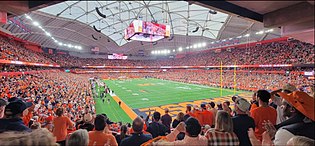
Construction
[edit]
Huber, Hunt and Nichols, Inc. was the general contractor and Birdair Structure Inc. was in charge of construction of the inflatable roof.[21] The original 220-ton roof was supported by sixteen 5-foot (1.5 m) diameter fans, each capable of generating 95,000 cubic feet (2,700 cubic metres) of air movement per minute, located in mechanical rooms on the north and south sides of the building. The fans directed over one million cubic feet of air per minute upward through the Dome's 36 main columns and under the roof.[21] To avoid the accumulation of snow, air heated to 160 °F (71 °C) was pumped into the dead air space between the two layers of its roof to melt any snow before it could accumulate.[21] The project involved more than 80 companies and transformed 30,000 cubic yards (23,000 cubic metres) of concrete and 880 tons of steel into the fifth largest domed stadium in the United States at the time of completion.[19][21]
Renovations
[edit]
The Dome has been upgraded several times throughout the past 25 years. The inflatable roof was replaced in 1999 at a cost of $14 million; university officials sought to replace the inflatable roof with a cable-supported roof similar to the Georgia Dome but was ruled out due to costs and the time-frame needed for construction.[22] FieldTurf was installed at the beginning of the 2005 football season, replacing the outdated AstroTurf. Additionally, the Dome received orange paint and banners between its decks, and its corridors were lined with historic photographs. In 2012, the university installed large end zone video displays, a 360-degree LED ribbon display, and an upgraded play clock.[23]


In May 2018, the university announced a major renovation to the Carrier Dome as the central portion of a larger campus update. The renovation, estimated to cost $118 million, was expected to be completed in 2022. The most significant changes are the replacement of the original air-supported roof with a fixed roof, two-thirds of which is translucent, along with the installation of air conditioning. The new roof was designed and engineered by Geiger Engineers[24] - the same firm that was the structural engineer for the original stadium. The new roof was finished in September 2020; air conditioning was added for some spaces in 2020 and will be in place throughout the stadium by 2022. The upgrade also included a new scoreboard (that will be center hung over the football field and can be moved to be over the basketball court), new lighting and sound systems, Wi-Fi improvements, accessibility upgrades, improved restrooms, and new concession spaces. Unlike the original air-supported roof, the new roof does not require snow removal during winter storms. The new roof is also expected to make the Dome a more viable venue for major concerts; the original air-supported roof required the stadium have air locks, making it difficult to move equipment in and out. The high-profile renovation project was named a winner of NCSEA's 2021 Excellence in Structural Engineering Award for Forensic / Renovation / Retrofit / Rehabilitation Structures over $20 Million[25][26]
The school announced the next phase of its work to enhance, elevate and expand the stadium experience in April 2022. This included an upgrade of the entire digital infrastructure, including latest 5G technology and wireless connectivity.[27] In December 2022, the university announced the next phase of its work towards enhanced stadium experience, which will include a complete replacement of benches with individual seats; a construction of a new publicly accessible event facility adjacent to the Dome; and an upgrade of the entire digital infrastructure. This phase two work will begin in spring 2023 following Commencement and will be completed ahead of the 2024 football season.[28][29]
Naming rights
[edit]The stadium was initially called the Carrier Dome, after the Carrier Corporation, who had a manufacturing campus in the area, gave the university $2.75 million naming rights grant towards its completion in 1979.[18] This gift represented the first naming agreement for a college sports stadium and one of the first in all of sports.[30]
On May 19, 2022, Syracuse University announced the signing of a 10-year naming rights deal of the iconic on-campus stadium with locally based networking equipment manufacturer JMA Wireless, ending its 42-year deal with Carrier. For the first time since the venue opened its doors in 1980, the stadium had a new name, only the second in its history—the JMA Wireless Dome, referred to as the JMA Dome.[30]
Accessibility and transportation
[edit]The JMA Wireless Dome is served by CENTRO buses. Shuttle buses transport fans to and from remote parking lots. Dedicated drop-off and pickup points for ride-hailing apps are maintained during game times.
OnTrack, the city's suburban rail line, served the Dome via its Syracuse University-Carrier Dome Station from 1994 to 2008. Service north to Armory Square and Destiny USA was offered year round, and south to Jamesville Beach seasonally. On game days, a special "Orange Express" service was offered.
Notable events
[edit]Attendance records
[edit]
Syracuse University's men's basketball per-game and single-season attendance numbers are annual contenders for the top rank in the nation. Lacrosse crowds are not as large, but the venue allows Syracuse's lacrosse teams to play home games throughout the February–May regular season. During the construction, Athletic Director Jake Crouthamel, to much protest from basketball head coach Jim Boeheim, decided to install a basketball court underneath the turf subsurface. This change, along with creation of the Big East conference, catapulted the attendance from around 9000 at Manley Field House to routinely topping 30,000, making the program NCAA leader in attendance for 11 consecutive seasons starting in 1985.[15]
The Carrier/JMA Wireless Dome has seen many of NCAA basketball's largest crowds. On February 1, 2014, the attendance record for an NCAA men's basketball on-campus game was broken by a few hundred spectators in the Duke vs. Syracuse ACC matchup. Attendance was announced as 35,446, as Syracuse went on to win 91–89, in dramatic fashion in overtime. This win marked the 21st straight win of the season for the Orange, breaking a school record for the longest unbeaten streak to start a season. The previous attendance record was set February 23, 2013 (35,012), the final game vs. long-standing Big East Conference rivals Georgetown Hoyas, as a member of the Big East. The Orange were defeated 57–46, ending the Orange's home win-streak at 38 games.[31] Prior to the Georgetown Hoyas attendance record, Syracuse University held the previous attendance record also. On February 27, 2010, an announced attendance of 34,616 came to see the Orange beat the Villanova Wildcats 95–77.[32] University officials briefly considered moving the basketball court to the middle of the football field for the 2014 regular season game with Duke- a move that could have pushed the attendance over 50,000. It was decided, to appease season ticket holders, that the court would stay in its usual location.[33] However, the university did reconfigure the stadium to hold a new record capacity of 35,446.[34]
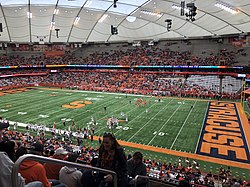
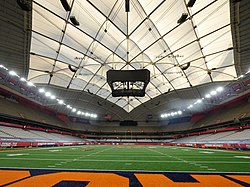
For the 2018–19 season, Syracuse modified the stadium's basketball configuration to allow a maximum crowd of 35,642, and on February 23, 2019, the Orange drew that exact number for the visit of then top-ranked Duke, setting a new single-game record for on-campus college basketball attendance.[35] This number ultimately surpassed the entire regular-season home attendance of 180 different NCAA Division I men's teams in that same season—more than half of the 353 teams that played in Division I.[36]
On March 19, 2007, a new NIT attendance record was set, at 26,752, in the second-round men's basketball game against the San Diego State University Aztecs.[37]
On November 22, 2014, the Syracuse Crunch of the American Hockey League set a new "United States Indoor Professional Hockey" record by playing in front of 30,715 fans at the Carrier Dome for the "Toyota Frozen Dome Classic".[38] Syracuse defeated the Utica Comets 2–1.[39] The (SUNY) Oswego State Lakers also hosted a game against the Utica Pioneers, establishing an NCAA record attendance for a Division III hockey game at 7,074 fans. Oswego tied Utica with a final score of 4-4.[40]
Tournaments
[edit]The 1981 Big East Conference men's basketball tournament was held there, as were the 1988 and 1991 Division I NCAA Men's Lacrosse Championships. The Men's NCAA basketball tournament East Regional semi-finals and finals have been held at the JMA Wireless Dome seven times (1983, 1997, 2000, 2002, 2005, 2010, and 2015). The NCAA Men's Division I Indoor Track and Field Championships were held there in 1984 and 1985.
Performing artists
[edit]Artists who have performed at the stadium include Red Hot Chili Peppers, The Chainsmokers, Paul McCartney, Prince, Bon Jovi, David Bowie, Van Halen, Elton John, Billy Joel, Bruce Springsteen, Garth Brooks, Rod Stewart, U2, Genesis, the Rolling Stones, The Police, Frank Sinatra, the Who, Neil Diamond, Kid Cudi, Kanye West, Grateful Dead, Metallica, Santana, Duran Duran, Kenny Chesney, Ludacris, Rick Ross, Meek Mill, Taylor Swift, Pink Floyd, Zac Brown Band, Macklemore Macklemore & Ryan Lewis, Kesha, Kaskade, 50 Cent, Trey Songz, Drake, and Travis Scott among others.[41]
Other events
[edit]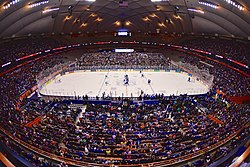
The March 28, 1981, WBC world Welterweight boxing championship contest between champion Sugar Ray Leonard and challenger Larry Bonds, won by Leonard by tenth-round technical knockout, was held at the Carrier Dome, as the main event of a program that also featured Tony Ayala Jr., Bernard Taylor, Alex Ramos and future world champions Johnny Bumphus and Davey Moore.[42]
On August 23, 1981, the Carrier Dome hosted an NFL exhibition game between the New Orleans Saints and the Philadelphia Eagles.
Each October, the stadium hosts the New York State Field Band Conference marching band championships. It also hosts the New York State High School Football Championships each November. A Billy Graham crusade took place at the JMA Wireless Dome in 1989. WWE have held numerous wrestling events at the JMA Wireless Dome going back to their WWF days. Since 2011, the stadium has been a stop on Monster Jam's stadium tour schedule.
On October 14, 2014, the Carrier Dome held an NBA preseason game between the New York Knicks and Philadelphia 76ers, which was a homecoming for the latter team, as they originated in Syracuse as the Nationals, departing Central New York in 1963.[43]
On November 22, 2014, the Syracuse Crunch and Utica Comets hosted an American Hockey League game inside the Carrier Dome as part of the Frozen Dome Classic, which served as the 2014–15 edition of the AHL Outdoor Classic.[38][39] This event was part of a day-long hockey event that also included the Utica College Pioneers and Oswego State Lakers, both based in NCAA Division III.[40] Also, the cities of Syracuse and Utica participated in a law enforcement charity game.[44]
The New York Mets conducted a pre-season practice at the Carrier Dome on March 26, 2019. It was the first baseball event staged at the Carrier Dome.[45]
The stadium has also been used as a large classroom as well as for academic research projects.[46][47][48]
Accidents
[edit]The Carrier Dome has also been the site of a fatal accident. In June 1999, worker Bryan Bowman was killed when he fell through the dome roof to the bleachers 60 feet (18 m) below. He had been working with a crew from Birdair Incorporated, to replace the roof.[49] The next month an electrician named Dave Paduana fell down a 50-foot (15 m) shaft while installing cables for a new speaker system. He survived with injuries to his leg, arm, back and ribs.[50]
See also
[edit]References
[edit]- ^ "About the Dome". Retrieved 2024-08-30.
- ^ "Carrier Dome – StadiumDB.com". Archived from the original on 2017-04-16. Retrieved 2017-05-06.
- ^ Freeman Galpin, William; Wilson, Richard; Green, John Robert; Oscar Theodore, Barck (November 1998). Syracuse University: The Eggers Years (First ed.). Syracuse, N.Y.: Syracuse University Press. p. 286. ISBN 0-8156-8108-9. Retrieved November 6, 2013.
- ^ a b "Syracuse University Buildings: Carrier Dome". Syracuse University. Archived from the original on 2014-10-15. Retrieved November 6, 2013.
- ^ Brown, Abram (September 15, 2010). "As It Stands: Despite 3 Decades of Weathering Carrier Dome Remains Face of Syracuse". The Daily Orange. Syracuse University. Archived from the original on March 5, 2016. Retrieved August 8, 2013.
- ^ "History of the Carrier Dome". Syracuse University Athletics. Archived from the original on December 18, 2008. Retrieved December 21, 2008.
- ^ "Syracuse University, JMA Wireless Announce Naming Rights Partnership, Usher in the JMA Wireless Dome Era". SU News. 19 May 2022. Retrieved 2023-12-11.
- ^ NCAA Attendance Records 2020 | http://fs.ncaa.org/Docs/stats/m_basketball_RB/2021/Attend.pdf
- ^ "Carrier Dome Crowds 30,000+ attendance". Orange Hoops. March 3, 2010. Archived from the original on March 2, 2011. Retrieved May 29, 2010.
- ^ Carlson, Chris (23 February 2019). "Syracuse-Duke sets college basketball attendance record". syracuse.com. syracuse.com. Archived from the original on 27 April 2019. Retrieved 27 April 2019.
- ^ Greene, John (1999-01-01). "The Eggers Years". Syracuse University Magazine. 15 (4).
- ^ "Deja vu: Four decades ago, Syracuse community fought over plans to build an SU stadium". syracuse.com. 2014-03-11. Retrieved 2020-01-20.
- ^ History: 126 Years of Syracuse Football (PDF). 2016 Syracuse University Football Media Guide (Report). Syracuse Orange. p. 105. Archived (PDF) from the original on August 26, 2016. Retrieved August 3, 2016.
- ^ "The Loud House". Syracuse University. Archived from the original on August 9, 2019. Retrieved August 9, 2019.
- ^ a b Ramsey, Ethan (6 November 2005). "The Odyssey: After 30 years of twists and turns, Jim Boeheim has evolved into a man much different from the one who started on Syracuse's sideline". The Daily Orange. Retrieved 17 May 2023.
- ^ "Syracuse Dedicates Jim Boeheim Court". National Association of Basketball Coaches. 2002-02-24. Archived from the original on 2021-12-11. Retrieved 2020-01-20.
- ^ "Introducing 'Ernie Davis Legends Field at the Carrier Dome'" (Press release). Syracuse University Athletics. October 1, 2009. Archived from the original on December 31, 2013. Retrieved November 6, 2013.
- ^ a b "Carrier 100th Anniversary: Dome Sweet Dome". Carrier Corporation. November 25, 2002. Archived from the original on September 29, 2007. Retrieved December 27, 2007.
- ^ a b Ziegler, Lou; Garcia, Juan (17 May 1981). "Sixteen Fans and 50,000 Spectators". Democrat and Chronicle. pp. 23–29. Retrieved 28 September 2022 – via Newspapers.com.
- ^ Marc, David (Fall 2005). "The Carrier Dome Legacy: Dome Sweet Dome". Syracuse University Magazine. 22 (3). Syracuse University. Archived from the original on June 12, 2010. Retrieved December 27, 2007.
- ^ a b c d "History of the Dome". Cuse.com. Syracuse University. Retrieved September 6, 2022.
- ^ Mink, Nate (May 14, 2018). "We've been talking about the Carrier Dome roof for almost 25 years". The Post-Standard. Archived from the original on July 31, 2019. Retrieved July 31, 2019.
- ^ "Carrier Dome LED Video Boards: The Last Piece of the Puzzle". Syracuse University. Retrieved April 30, 2021.
- ^ "Carrier Dome". Fabritec Structures. Retrieved April 30, 2021.
- ^ "JMA Wireless Dome (formerly Carrier Dome) at Syracuse University". Geiger Engineers. Retrieved 2022-05-25.
- ^ Carlsson, Chris (May 14, 2018). "Syracuse's $118 million Carrier Dome renovations to include new roof, air conditioning". The Post-Standard. Syracuse, NY. Archived from the original on May 16, 2018. Retrieved May 16, 2018.
- ^ "Syracuse University to Rename On-Campus Stadium, Readies Next Phase of Transformation". Syracuse University News. 2022-04-20. Retrieved 2022-05-19.
- ^ Carlson, Chris (2 May 2022). "What's the new building going up next to the Carrier Dome? A pregame fan lounge to thin out crowded concourses". syracuse.com. Retrieved 19 December 2022.
- ^ "Transformation of JMA Wireless Dome Continues, University Readies Installation of New Seats, Other Enhancements". Syracuse University News (Press release). 8 December 2022. Retrieved 19 December 2022.
- ^ a b "Syracuse University, JMA Wireless Announce Naming Rights Partnership, Usher in the JMA Wireless Dome Era". Syracuse University News (Press release). 2022-05-19. Retrieved 2022-05-19.
- ^ Clarke, Liz (February 23, 2013). "Georgetown vs. Syracuse: Otto Porter's career-high 33 points carries Hoyas to win at Carrier Dome". The Washington Post. Archived from the original on February 24, 2013. Retrieved February 24, 2013.
- ^ "Jackson, Onuaku Help Orange Drop Wildcats in Front of Record Crowd". ESPN. February 27, 2010. Archived from the original on March 2, 2010. Retrieved February 27, 2010.
- ^ Waters, Mike (August 22, 2013). "It's Official: Syracuse Will Not Move Its Basketball Court to Middle of the Carrier Dome for Duke Game". The Post-Standard. Syracuse. Archived from the original on August 26, 2013. Retrieved August 22, 2013.
- ^ Samuels, Brett (January 30, 2013). "Syracuse expects record crowd of 35,446 for Duke game". The Daily Orange. Syracuse. Archived from the original on February 2, 2014. Retrieved January 31, 2014.
- ^ Jung, Tristan (February 23, 2019). "Syracuse vs. Duke Breaks NCAA On-Campus Attendance Record With Crowd of 35,642". Sports Illustrated. Archived from the original on February 25, 2019. Retrieved March 20, 2019.
- ^ Lopresti, Mike (March 19, 2019). "Here's 1 surprising fact about every team in the 2019 NCAA tournament". NCAA.com. Retrieved March 20, 2019.
- ^ "NIT Record 26,572 See Orange Beat San Diego State". Syracuse University Athletics. March 17, 2007. Archived from the original on July 27, 2011. Retrieved September 30, 2009.
- ^ a b Kramer, Lindsay (23 November 2014). "Final attendance number for Frozen Dome Classic crushes previous U.S. indoor pro hockey record". syracuse.com. Retrieved 26 May 2020.
- ^ a b Kramer, Lindsey (23 November 2014). "Frozen Dome Classic: Syracuse Crunch beats Utica Comets in front of record crowd at Carrier Dome". syracuse.com. Retrieved 26 May 2020.
- ^ a b Burnsed, Brian (January 8, 2015). "Carrier Dome Freezes Over: Division III schools break a single-game attendance record". Champion. NCAA. Retrieved 26 May 2020.[permanent dead link]
- ^ Tulloch, Katrina (27 October 2020). "Carrier Dome concerts: Look back on 40 years of Dome music (video)". The Post-Standard. Retrieved 2 November 2020.
- ^ "BoxRec: Event". boxrec.com. Retrieved 2021-05-08.
- ^ Rappaport, Max (October 14, 2014). "Noel Shines In 84-77 Loss To Knicks". Philadelphia 76ers. Retrieved 26 May 2020.
- ^ "Crunch to host Comets at Carrier Dome". Archived from the original on 17 June 2014. Retrieved 13 June 2014.
- ^ "New York Mets to wrap up spring training in Carrier Dome". Archived from the original on 25 February 2021. Retrieved 13 March 2019.
- ^ Kobland, Keith (February 4, 2021). "Syracuse University's Beloved Stadium to Serve as Campus' Largest Classroom This Semester". SU News. Retrieved 5 February 2021.
- ^ Moriarty, Rick (10 February 2021). "Professor turns Carrier Dome into what could be nation's biggest classroom". Syracuse Post-Standard. Retrieved 13 February 2021.
- ^ Carlson, Chris (9 September 2020). "Syracuse University hopes Carrier Dome renovation allows students to use it as study space, use Club 44 as a classroom". syracuse.com. Retrieved 28 September 2022.
- ^ "Worker dies in fall at Carrier Dome". Democrat and Chronicle. June 9, 1999. Retrieved September 20, 2020 – via newspapers.com.
- ^ "Plunge at Carrier Dome seriously hurts worker". Democrat and Chronicle. July 16, 1999. Retrieved September 21, 2020 – via newspapers.com.
External links
[edit]| Events and tenants | ||
|---|---|---|
| Preceded by | Home of Syracuse Orange women's basketball 2006–present |
Succeeded by current
|
| Preceded by | Home of Syracuse Orange men's lacrosse 1980–present |
Succeeded by current
|
| Preceded by | Home of the NCAA Lacrosse Final Four 1988 |
Succeeded by |
- College football venues in New York (state)
- College lacrosse venues in the United States
- Covered stadiums in the United States
- Syracuse Orange basketball venues
- Syracuse Orange football venues
- NCAA Division I men's lacrosse tournament venues
- Indoor track and field venues in New York (state)
- American football in Syracuse, New York
- Lacrosse in Syracuse, New York
- Sports venues in Syracuse, New York
- Sports venues completed in 1980
- 1980 establishments in New York (state)
- Syracuse Orange lacrosse venues

